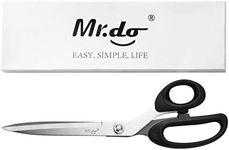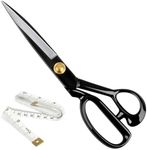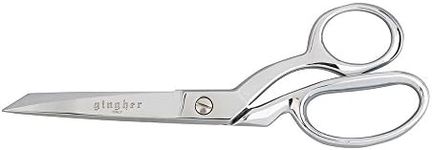Buying Guide for the Best Fabric Scissors
Choosing the right fabric scissors is essential for anyone who enjoys sewing, quilting, or crafting. The right pair will make cutting fabric easier, more precise, and more comfortable, while the wrong pair can lead to frustration, jagged edges, and even hand fatigue. When shopping for fabric scissors, it's important to consider how you'll use them, the types of fabric you work with, and your own comfort. Understanding the key features will help you find a pair that fits your needs and lasts for years.Blade MaterialBlade material refers to what the cutting part of the scissors is made from, and it greatly affects sharpness, durability, and maintenance. Most fabric scissors are made from stainless steel or high-carbon steel. Stainless steel blades resist rust and are easy to maintain, making them a good all-purpose choice. High-carbon steel blades are harder and can stay sharper longer, but they may require more care to prevent rust. If you work with tough or thick fabrics, high-carbon steel might be better, but for general use and easy care, stainless steel is often sufficient.
Blade LengthBlade length is the measurement of the cutting edge, and it determines how much fabric you can cut in one motion. Shorter blades (around 5-6 inches) offer more control and are great for detailed or small cuts, while longer blades (7-10 inches) allow you to cut through more fabric quickly and are ideal for long, straight cuts. If you mostly do small projects or intricate work, shorter blades are best. For cutting large pieces of fabric or making long, straight cuts, longer blades will save you time and effort.
Handle DesignHandle design affects comfort and ease of use, especially during long cutting sessions. Some handles are straight, while others are bent or offset to keep your hand above the fabric, which helps with accuracy and comfort. Ergonomic handles with soft grips can reduce hand fatigue and are especially helpful if you have arthritis or plan to cut for extended periods. If comfort is a priority or you cut a lot, look for ergonomic or padded handles. For occasional use, standard handles may be sufficient.
WeightThe weight of the scissors can influence how easy they are to use, especially over long periods. Heavier scissors can feel more stable and powerful, making them good for thick or multiple layers of fabric, but they may cause fatigue if used for a long time. Lighter scissors are easier to maneuver and less tiring, but may not cut as easily through heavy materials. If you often cut heavy fabrics, a bit of weight can help, but for light fabrics or frequent use, lighter scissors are usually more comfortable.
Edge TypeEdge type refers to whether the blades are straight or serrated. Straight edges are the most common and work well for most fabrics, giving a clean, smooth cut. Serrated edges grip slippery or delicate fabrics, like silk or chiffon, preventing them from slipping as you cut. If you mostly cut standard cotton or similar fabrics, straight edges are fine. If you work with slippery or delicate materials, consider scissors with a serrated edge for better control.
Right- or Left-Handed UseSome scissors are designed specifically for right-handed or left-handed users, while others are ambidextrous. Using scissors that match your dominant hand makes cutting easier and more comfortable, and helps you get a cleaner cut. If you are left-handed, look for scissors labeled for left-handed use, as these have reversed blades and handles for better control. Right-handed users can use standard scissors, while ambidextrous designs can work for both but may not be as comfortable for extended use.















